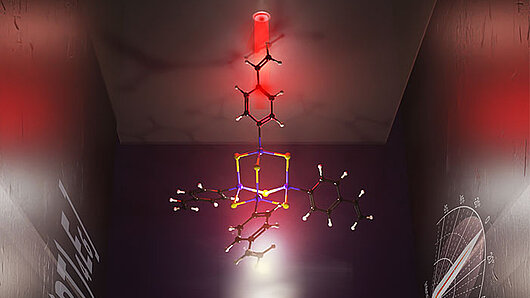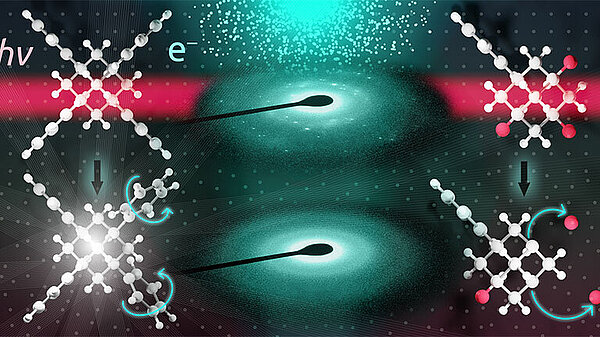High-Performance Computing Center Stuttgart

Unfortunately, however, white light generation by newer technologies such as light-emitting diodes (LEDs) is not straightforward and often relies on a category of materials called “rare-earth metals,” which are increasingly scarce. This has recently led scientists to look for ways to produce white light more sustainably. Researchers at Justus Liebig University Giessen, the University of Marburg, and Karlsruhe Institute of Technology have recently uncovered a new class of material called a “cluster glass” that shows great potential for replacing LEDs in many applications.
“We are witnessing the birth of white-light generation technology that can replace current light sources. It brings all the requirements that our society asks for: availability of resources, sustainability, biocompatibility,” said Prof. Dr. Simone Sanna, Giessen University Professor and lead computational researcher on the project. “My colleagues from the experimental sciences, who observed this unexpected white light generation, asked for theoretical support. Cluster glass has an incredible optical response, but we don’t understand why. Computational methods can help to understand those mechanisms. This is exactly the challenge that theoreticians want to face.”
Sanna and his collaborators have turned to the power of high-performance computing (HPC), using the Hawk supercomputer at the High-Performance Computing Center Stuttgart (HLRS) to better understand cluster glass and how it might serve as a next-generation light source. They published their findings in Advanced Materials.
If you are not a materials scientist or chemist, the word glass might just mean the clear, solid material in your windows or on your dinner table. Glass is actually a class of materials that are considered “amorphous solids;” that is, they lack an ordered crystalline lattice, often due to a rapid cooling process. At the atomic level, their constituent particles are in a suspended, disordered state. Unlike crystal materials, where particles are orderly and symmetrical across a long molecular distance, glasses’ disorder at the molecular level make them great for bending, fragmenting, or reflecting light.
Experimentalists from the University of Marburg recently synthesized a particular of glass called a “cluster glass.” Unlike a traditional glass that almost behaves as a liquid frozen in place, cluster glass, as the name implies, is a collection of separate clusters of molecules that behave as a powder at room temperature. They generate bright, clear, white light upon irradiation by infrared radiation. While powders cannot easily be used to manufacture small, sensitive electronic components, the researchers found a way to re-cast them in glass form: “When we melt the powder, we obtain a material that has all the characteristics of a glass and can be put in any form needed for a specific application,” Sanna said.
While experimentalists were able to synthesize the material and observe its luminous properties, the group turned to Sanna and HPC to better understand how cluster glass behaves the way it does. Sanna pointed out that white light generation isn’t a property of a single molecule in a system, but the collective behaviors of a group of molecules. Charting these molecules’ interactions with one another and with their environment in a simulation therefore means that researchers must both capture the large-scale behaviors of light generation and also observe how small-scale atomic interactions influence the system. Any of these factors would be computationally challenging. Modeling these processes at multiple scales, however, is only possible using leading HPC resources like Hawk.

Collaboration between experimentalists and theoreticians has become increasingly important in materials science, as synthesizing many iterations of a similar material can be slow and expensive. High-performance computing, Sanna indicated, makes it much faster to identify and test materials with novel optical properties. “The relationship between theory and experiment is a continuous loop. We can predict the optical properties of a material that was synthesized by our chemist colleagues, and use these calculations to verify and better understand the material’s properties,” Sanna said. “We can also design new materials on a computer, providing information that chemists can use to focus on synthesizing compounds that have the highest likelihood of being useful. In this way, our models inspire the synthetization of new compounds with tailored optical properties”
In the case of cluster glass, this approach resulted in an experiment that was verified by simulation, with modelling helping to show the researchers the link between the observed optical properties and the molecular structure of their cluster glass material and can now move forward as a candidate to replace light sources heavily reliant on rare-earth metals.
HPC plays a major role in helping researchers accelerate the timeline between new discovery and new product or technology. Sanna explained that HPC drastically cut down on the time to get a better understanding of cluster glass. “We spend a lot of time doing simulation, but it is much less than characterizing these materials in reality,” he said. “The clusters we model have a diamond-shaped core with 4 ligands (molecular chains) attached to it. Those ligands can be made of any number of things, so doing this in an experiment is time consuming.”
Sanna pointed out that the team is still limited by how long they can perform individual runs for their simulations. Many research projects on supercomputers can divide a complex system into many small parts and run calculations for each part in parallel. Sanna’s team needs to pay special attention to long-distance particle interactions across large systems, so they are limited by how much they can divide their simulation across computer nodes. He indicated that having regular access to longer run times—more than a day straight on a supercomputer—would allow the team to work more quickly.
In ongoing studies of cluster glass Sanna’s team hopes to thoroughly understand the origin of its light generating properties. This could help to identify additional new materials and to determine how best to apply cluster glass in light generation.
Sanna explained that HPC resources at HLRS were essential for his team’s basic science research, which he hopes will lead to new products that can benefit society. “The main computational achievement in this journal article was only possible through our access to the machine in Stuttgart,” he said.
-Eric Gedenk
Funding for Hawk was provided by Baden-Württemberg Ministry for Science, Research, and the Arts and the German Federal Ministry of Education and Research through the Gauss Centre for Supercomputing (GCS).